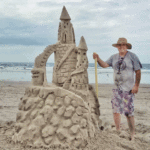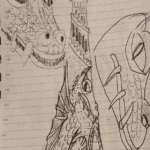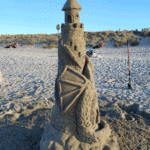How this Pāpāmoa father became king of the sandcastle
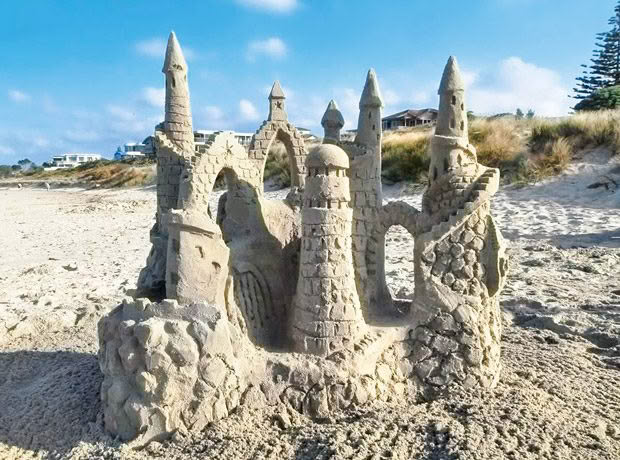
A nostalgic summer activity reaches new heights in the hands of a Bay of Plenty performance artist.
Words: Cari Johnson
Once, in a land not so far away, there lived a man who built soaring castles from sand. Beachgoers oohed and ahhed as he forged two-metre-high turrets and dungeons with little more than his hands, nay a bucket or two. And when the tide rolled in, this man would walk away, surrendering his fantastical handiwork to the sea.
Brett Muir, who works with international students at Mt Maunganui Intermediate, is a man whose ordinary pastime appears rather extraordinary. Sand is his medium; castles, his muse. “Everyone can relate to castles. A preschooler will look at a sandcastle and see Frozen. A child will ask if it’s from Harry Potter. A young adult may think of Game of Thrones. And a 70-year-old may see a castle they saw in Europe last year,” he says.
- Going for height.
- The planning for a dragon castle.
- The finished dragon castle.
His hobby took form some 20 years ago when he and his young children made simple bucket castles together. But what excited Brett, who lives at Pāpāmoa, became dull for his wife and kids — this was a man who could spend four hours on one castle.
Over time, his no-frills constructions were replaced with more elaborate creations, which he credits to techniques outlined in the how-to book Sandcastles Made Simple by Lucinda Wierenga. That, and his lineage. “Creativity runs like a river through my mother’s family, and it comes out in every generation. I see sandcastle building as how that trait is expressed in me,” he says.
In 2001 Brett’s beach hobby paid off — big time. He took a snapshot of one of his sandcastles for a nationwide summer photo competition and, to his surprise, won the Hyundai Santa Fe prize. “That was a turning point for me. People started to realize I wasn’t just antisocial. I was reasonably good at building sandcastles, and there was a payoff.”

Gone are the days of castles made with a $2 bucket. Over the years, Brett has accumulated a collection of makeshift tools, including baking tools (“don’t tell my wife”), a collection of buckets and one plastic straw. “The straw is my single most important tool. Sandcastles become extremely fragile as they dry, so you blow away the loose sand,” he says.
In 2015, he erected an intricate, two-metre-high castle for the New Zealand Sandcastle Competition in Christchurch. Spiral staircases, arrowslits and the stone-like texture no doubt helped sway the judges and public. He returned home as the winner of the people’s choice and individual adult categories.
It doesn’t take a national competition for people (or the occasional flying object) to be drawn to his work. Children delight in observing him for hours, quite possibly with hopes of recreating their own. Further along the beach, dogs, frisbees and volleyballs are like cannonballs to his fortified sand structures.

Brett’s winning castle of the New Zealand Sandcastle Competition in Christchurch
Once he even asked some police officers to guard a work in progress so he could cool off in the ocean. “They admitted it had been tempting to kick it over,” says Brett. “I said, ‘I know, that’s why you guarded it.’” These fragile-yet-mighty works can stand the test of time, at least figuratively. During the national lockdown, Brett was praised by locals when he shared a photo of his sandcastles with his community Facebook group.
Another lockdown castle of his made local headlines for its inspiring message. ‘Kia kaha Pāpāmoa’, was carved in block lettering on the front. “I think it gave people something positive to share with others. They felt special that it was on their beach and in their bubble,” says Brett.
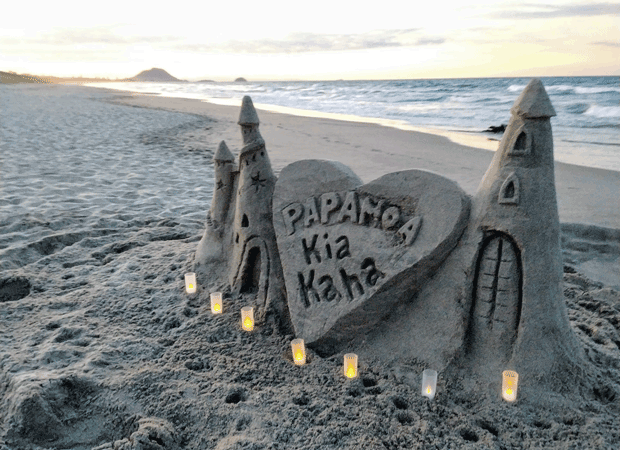
He is quick to point out that he is not a sand sculptor. Such professionals often use quarry sand, require construction-grade equipment and will craft just about anything with their medium.
“I’m not a trained artist, and castles are much more forgiving. Castles are grungy and organic — they’re old, they’ve been in battle, parts have fallen down and built back up. Sandcastle-building is performance art. I’m lucky if I can get to the end of a build and the castle is still standing.”
BRETT’S SANDCASTLE TIPS
Test the sand. Fine, silt-like sand is white gold to a sculptor like Brett. “The first thing I do at the beach is to scrunch up my toes to feel the sand.”
Cut the bucket. ”Cut the bottom from your bucket. Then pack with wet sand and slowly slide off the bucket. The taller the bucket, the more height you get.”
Carve from top to bottom. ”If you work on the bottom first, the sand at the top will fall onto the bottom and smash what you’ve done.”
Don’t look back. ”The minute you’re finished with it, it’s not yours anymore. The sea will eventually take it. Sandcastles are fragile beasts.”
Love this story? Subscribe now!
 This article first appeared in NZ Life & Leisure Magazine.
This article first appeared in NZ Life & Leisure Magazine.
